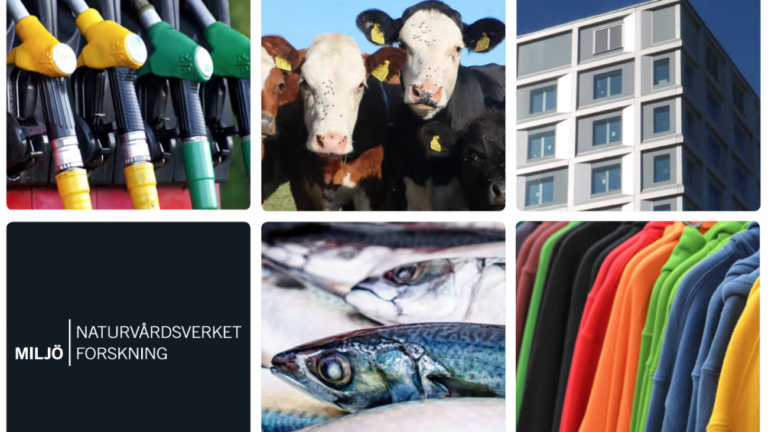Footprint results overview
The method and model were completed in 2019, with results for the following footprints for all Swedish consumption, between 2014-2018: material footprint (including bio-based materials, fossil fuels, metals and non-metallic minerals), water footprint (blue water consumption), land footprint, greenhouse gas footprint, other emissions to air footprints (Particulate Matter (PM10, PM2.5), Nitrous oxide (N2O), Nitrogen oxides (NOx), Sulphur dioxide), energy use footprints (from fossil-fuels and biofuels).
These data provide the most complete picture of Sweden’s global consumption footprint yet available. Since then, the project team has received renewed funding to conduct a gap analysis in four thematic areas: fish, land use change, biodiversity and chemicals. This analysis will explore the possibilities for regularly estimating footprints for these indicators, along with the potential for more footprint data to be regularly updated and become part of official statistics.
The PRINCE project also investigates several specific impact areas, including water scarcity, GHG emissions from international shipping, the impact of ICT products consumption among others. See the publications pages for these in-depth investigations.
You can download all the 2008-2014 time series of footprint data in Excel format below. On this page, you’ll find a selection of our results, mapped to indicate the global hotspots of environmental pressure associated with Swedish consumption in 2014.
Time-series data from the PRINCE Model 2008-2014
Selection of footprint results mapped for 2014
Figure 1. PRINCE indicators for 2014: Geographic hotspots of greenhouse gas emissions associated with Swedish consumption
Note: Shading reflects the total value for the country or region.
Nitrogen Oxides
Figure 2 shows the distribution of Sweden’s consumption-based nitrogen oxides (NOx) footprint across product groups consumed in Sweden. It also indicates the type of consumption (by households, by government or in the form of investments).
The largest product group hotspot is Food products (almost all consumed by private households), followed by Construction (investments) and three product groups likely to contain a large proportion of vehicle transport: Wholesale and retail, Household direct emissions and Warehousing and postal services (chiefly by government).
Figure 2. PRINCE indicators for 2014: Top 20 hotspot product groups for nitrogen oxides (NOx) emissions associated with Swedish consumption, showing type of consumption
Based on preliminary PRINCE data.
Case Studies
-
 03 Feb 2019
03 Feb 2019Estimating greenhouse gas emissions from international shipping
A spatially explicit data-driven approach to calculating commodity-specific shipping emissions per vessel Schim van der Loeff, W., Godar, J., and Prakash, V. (2018). Journal of Cleaner Production,…
-
 21 Aug 2020
21 Aug 2020Examining Sweden’s water footprint from water scarce areas
Extending the PRINCE water use results with water scarcity weighting Water extraction in water-rich and water-scarce areas can have very different impacts on ecosystems and…
-
 11 Jan 2019
11 Jan 2019The footprint of information and communication technology consumption in Sweden and the EU
A multi-impact analysis of changing ICT consumption patterns for Sweden and the EU: Indirect rebound effects and evidence of decoupling Joyce, P. J., Finnveden, G.,…
Reports summarising the PRINCE project
-
 21 Dec 2015
21 Dec 2015Policy-relevant Indicators for National Consumption and Environment: Summaries of research and scientific papers from the PRINCE project
Policy-relevant Indicators for National Consumption and Environment: Summaries of research and scientific papers from the PRINCE project This booklet combines an overview of the research…
-
 01 Nov 2018
01 Nov 2018Miljöpåverkan från svensk konsumtion: Nya indikatorer för uppföljning
Miljöpåverkan från svensk konsumtion: Nya indikatorer för uppföljning Steinbach, N., Palm, V., Cederberg, C., Finnveden, G., Persson, L., Persson, M., Berglund, M., Björk, I., Faure,…